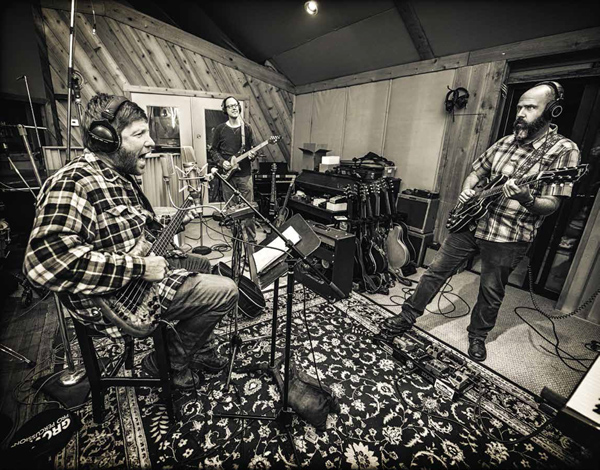Reel Time: Al Schnier on moe.‘s New Studio Album

Photo by Jay Blakesberg
In mid-October moe. entered Stamford, Conn.’s Carriage House Studios to begin work on their latest studio album. The as-yet-untitled record is slatedfor release in the late spring and produced by Dave Aron, whose credits include Prince, Sublime, Tupac Shakur, Biggie Smalls and Snoop Dogg. What began as an acoustic project morphed into something altogether different, as moe.’s Al Schnier explains, near the close of the group’s three weeks at Carriage House.
Acoustic Origins
Initially, this record was going to be very much an acoustic, rootsy record. We were going to make something decidedly less electric and much more organic than anything we’ve done before. The reception we had gotten from the acoustic bonus disc we made last time [to accompany What Happened to the LA LAs] was really overwhelming, so we figured this was the perfect timing.
That was sort of the plan going in. However, things changed. The original producer we were going to work with had a bunch of scheduling conflicts, so that became an issue. The studio we were going to do it in was no longer available—that became an issue. So we called an old friend, Dave Aron, whose list of credits is kind of ridiculous. The amount of stuff he’s done is amazing, but he’s also a guy we’ve known for 15 years. He’s probably been to 30 moe. shows. He’s someone we see on the West Coast every time we’re out there—just a friend of ours.
We thought, “Well, maybe Dave’s our guy and we’ll make this acoustic record in his studio in LA,” but then we changed gears again. Ultimately, we ended up at a studio in New England with Dave, making a total rock album that is all moe.
moe. Being moe.
Many of the songs that started out as acoustic songs ended up becoming epic rock songs, and a lot of our demos are like that. I could write a song on the acoustic guitar, and we could have done it like Johnny Cash would have done it—three chords and the truth. But we mostly decided to put them through the moe. ringer, where everyone brings their skill to the table and we turn it into a moe. song. Rather than force something else, we felt like we just needed to be moe.
Third Party Listener
Bringing Dave in as a designated third party—a set of ears and somebody to moderate the process—has been beneficial to us. I’m surprised by how easy this record has been and how much work we’ve gotten done. Working with Dave has been fantastic. He’s been really good at telling us when a song is done or a part is done and when to leave it alone before it gets overcooked.
More Than a 10-Pack
The discussion that has come up several times throughout this process is whether or not anybody is going to listen to the album in its entirety, in sequence anymore. If there is a vinyl release, will there be a Side A and a Side B that will have an impact on people? If we release this thing, can it be 60 minutes long or is that too much music for one sitting? Are we making an album or are we putting out a new collection of songs that people can mix and match as they please, however they decide to use them? These are the discussions we’re having. At the end of the day, we’re still leaning toward putting out an album because that’s what we know, that’s what we do. We hope that our fans still appreciate an album at this point. Otherwise, we could just be releasing songs as a 10-pack of songs that don’t have to be in a particular order.
The Whirlwind
On the last record, we had been playing all the songs except for one [“One Way Traffic”] on the road since before the record. That was sort of the idea: taking songs, playing them out live and putting them through their phases before we went into the studio. The record before that, we went into the studio with no songs. We wanted to write the whole thing together in the same place and time. That was the intent for that record. This time, we wrote a bunch of stuff and didn’t bring it out live. We just mailed the tracks around to each other. We spent a day or two working on this stuff before we got to the studio, but most of the work was done in the studio. We had a list of 20-plus songs and we just prioritized them. The ones that made the top of the list were unanimous songs, ones that everyone felt were strong and essential for the record. Then we went down from there. moe. doesn’t have a history with these songs, which is interesting. We put all of this energy into a particular song for several days to birth it and raise it and then, we abandon it and move on to a different song. The process has been a whirlwind of creativity for three weeks, every single day. It’s been a very cathartic process.



















